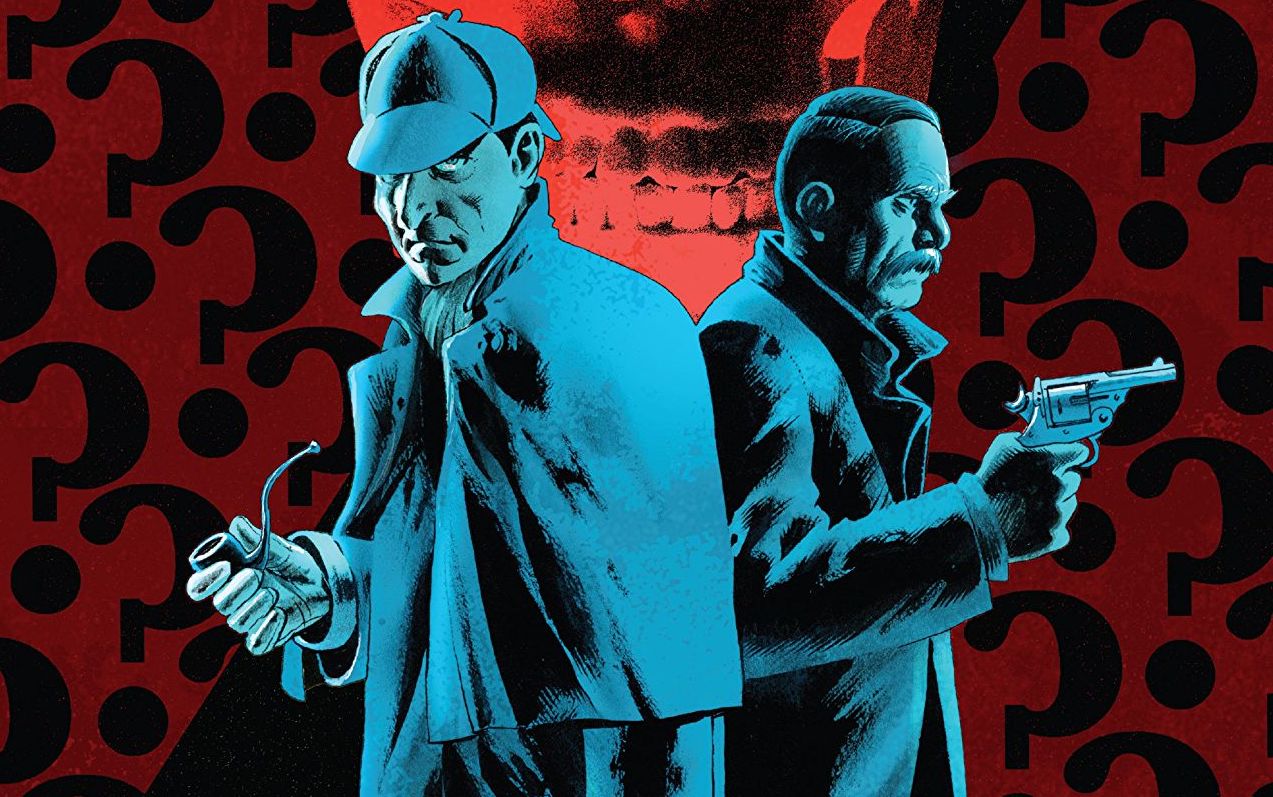[amazon_link asins=’1785658425′ template=’AiPTProductAd’ store=’aiptcomics-20′ marketplace=’US’ link_id=’b080bd5c-7056-48ad-8f71-eda3e4d29879′]
A family man has gone missing and Sherlock Holmes is on the case! What happened to Michael Williams and what is the connection between his disappearance and the London Necropolis Railway?
One thing that I greatly appreciated about this series is that it correctly assumed that anyone picking it up would be familiar with Sherlock and Dr. Watson, even if they haven’t read Dynamite’s other Sherlock Holmes comics. There’s no lengthy exposition explaining who either of them are and, aside from a few asides about the purpose of the Baker Street Irregulars, nothing much in the way of explanation for Sherlock’s world. I haven’t read any of the previous Holmes books from Dynamite, but I will be picking them up after reading this.
Like many of Sir Arthur Conan Doyle’s strongest Sherlock Holmes stories, The Vanishing Man’s resolution is surprising, but totally visible upon a second read. The script sprinkles the clues throughout, but thanks to Holmes’ cavalier attitude, they all appear to simply be bits of inconsequential conversation.

Aside from Leah Moore and John Reppion’s well-written mystery and Julius Ohta’s gracefully-illustrated action sequences (there’s a particularly excellent fight in an opium den), this miniseries really shines when it comes to its character work.
This series has a firm grasp on what makes Holmes so compelling. I love the glimpses at Holmes’s nihilism that are peppered throughout the story. There’s a delicate balance being struck, showing that he is genuinely invested in solving the case, but he will not suffer fools. When he’s told that the fellow who has disappeared was kind, generous, and upstanding, he can’t help sniffing at the idea of a “perfect” gentleman. Holmes is damaged. If he can’t find a challenge worthy of his intellect, then he’ll dull his mind with drugs. He’s in a low point and he’s seen enough of the world’s ugliness to be more than a little hesitant to believe that people can be better.
Holmes needs John Watson to act as his conscience, which Watson does on several occasions in this story. The Vanishing Man presents Watson as a man who deeply respects Holmes, but will not hesitate to tear into him if he’s being irresponsible for endangering others. He also abhors violence, but is more than willing to throw his fist when the occasion calls for it.

Aside from his preferred “seven-per-cent solution,” Holmes is a man also addicted to challenge. He needs something to stimulate him and he’ll seek it out in whichever back alley he can find it. The Vanishing Man presents us with a Sherlock Holmes who cannot be left alone in his own thoughts, which makes Watson the ideal best mate and sounding board in his adventures. Without something or someone to apply his skills towards, Holmes would either go mad or overdose.
Which brings us to Professor James Moriarty.
Sherlock’s future arch-nemesis spends much of this miniseries skulking about in the shadows, inextricably tied to every facet of the Case of the Vanishing Man. Moriarty is a subject of much interest for writers after Sir Doyle, since he’s not a major figure in the majority of the original stories. This allows Moriarty to be adapted in many different ways, depending on the medium. We only get a few scenes with the Doctor in this miniseries, but it establishes him as a formidable foe not only due to his intellect, but also because of his uncanny ability to predict Sherlock’s behavior. When even Holmes’ closest friends and associates can scarcely tell what’s going on in the detective’s head, this aspect of Moriarty’s planning ensures he’ll be a thorn in Holmes’ side for some time to come. I’m hopeful that Dynamite’s next Sherlock series picks up this particular thread.
Another fun characterization in this series is that of Inspector Lestrade, the eternally exasperated detective from Scotland Yard. His portrayal here brought to mind Inspector Koichi Zenigata from the Lupin III anime and manga. Harried, anxious, adorned in a floppy hat, Lestrade just wants to get results and is constantly flustered by Holmes’ diversions and half-answers. He doesn’t add terribly much to the story, but it’s fun to have him along.
One complaint would be that there are a few scenes that don’t entirely pay off. Some of this is explained away as being scenarios manufactured by Moriarty to throw Holmes off his scent, but it does occasionally feel as though the story was padded out unnecessarily in some spots. Also, there’s a subplot about Holmes’ irresponsibility regarding his Baker Street Irregulars that doesn’t entirely pan out. The story is resolved, but it doesn’t truly feel like Holmes was changed much by the incident. This could prove to be something that drives him in Dynamite’s next volume, but it reads as unfinished business at this point.
Sherlock Holmes: The Vanishing Man is a fun read that gets so much right about its title character. The hints toward future stories are enticing, too. Hopefully we won’t have to wait too long for Holmes and Moriarty to face each other again!
Join the AIPT Patreon
Want to take our relationship to the next level? Become a patron today to gain access to exclusive perks, such as:
- ❌ Remove all ads on the website
- 💬 Join our Discord community, where we chat about the latest news and releases from everything we cover on AIPT
- 📗 Access to our monthly book club
- 📦 Get a physical trade paperback shipped to you every month
- 💥 And more!














You must be logged in to post a comment.